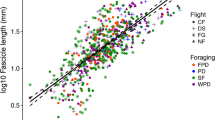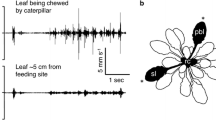Summary
-
1.
Experiments were designed to examine phase-dependent influences of the wing stretch receptor (SR) afferents on the central oscillator in the flight system of the locust. Reasons were also sought for the failure of earlier workers to find phase-dependent influences of SR activity on the flight oscillator.
-
2.
In preparations with the hindwing sensory nerves left intact, electrical stimulation of the two forewing SRs caused an immediate increase in oscillator frequency reaching a maximum of 16–20 Hz as described by Pearson et al. (1983). After cutting the hindwing sensory nerves, the same stimulation increased the frequency from 6–8 Hz to 12–14 Hz. The absolute reduction in cycle period caused by the stimulation was reduced from 15–25 ms to 10–15 ms as a result of cutting the hindwing sensory nerves.
-
3.
Stimulation of two forewing SRs in completely deafferented preparations in bursts occurring at a constant rate could entrain the flight oscillator. During entrainment, depressor spikes occurred close to the time of the stimulus. The flight oscillator could follow changes in the entrainment frequency, usually only up to 1 Hz (10% cycle period) compared to 4–6 Hz (40–50% cycle period) seen by Pearson et al. (1983). Entrainment could still be elicited when the chordotonal organ afferents were co-stimulated.
-
4.
Bilateral stimulation of the hindwing SRs could also entrain the central flight oscillator over a similar range of frequencies as was observed for forewing SR stimulation.
-
5.
Stimulation of a lateral pair of SRs (one forewing and the ipsilateral hindwing SR) was observed to produce 1∶1 entrainment in only one out of fifteen animals. However, a phase-dependent influence on the oscillator rhythm could be demonstrated by stimulation time-locked to the oscillator output (depressor EMG). SR stimulation close to the time of the depressor spike increased the oscillator frequency and prolonged the duration of rhythmic activity. Stimulation occurring approximately midway between depressor bursts had no obvious effect on the frequency or duration of the oscillator rhythm.
-
6.
The only conditions under which a slow increase in oscillator frequency could be produced by stimulation of a lateral pair of SRs was when the SR stimulus frequency was set much higher than the central oscillator frequency. It is concluded that the failure of earlier workers to observe phase-dependent effects of SR stimulation on the oscillator frequency was due to stimulation of a lateral rather than segmental pair of SRs and the method they used in their attempt to demonstrate phase-dependence. Their observation of a slow phase-independent increase in flight frequency possibly resulted from the high SR stimulus frequencies employed.
Similar content being viewed by others
Abbreviations
- EMG :
-
electromyogram
- SR :
-
stretch receptor
References
Altman JS, Anselment E, Kutsch W (1978) Postembryonic development of an insect sensory system: ingrowth of axons from hindwing sense organs inLocusta migratoria. Proc R Soc Lond B 202:497–516
Andersson O, Forssberg H, Grillner S, Wallen P (1981) Peripheral feedback mechanisms acting on the central pattern generators for locomotion in fish and cat. Can J Physiol Pharmacol 59:713–726
Aschoff J (1965) Circadian clocks. North Holland, Amsterdam
Burrows M (1975) Monosynaptic connexions between wing stretch receptors and flight motoneurons of the locust. J Exp Biol 62:189–219
Farley RD, Case JF (1968) Sensory modulation of ventilative pacemaker output in the cockroach,Periplaneta americana. J Insect Physiol 14:591–601
Gettrup E (1966) Sensory regulation of wing twisting in locusts. J Exp Biol 44:1–16
Horsmann U, Wendler G (1985) The role of a fast wing reflex in locust flight. In: Gewecke M, Wendler G (eds) Insect locomotion. Paul Parey, pp 157–165
Kien J, Altman JS (1979) Connections of the locust wing tegulae with metathoracic flight motoneurons. J Comp Physiol 133:299–310
Kutsch W (1974) The influence of the wing sense organs on the flight motor pattern in maturing adult locusts. J Comp Physiol 88:413–424
Möhl B (1985) The role of proprioception in locust flight control. III. The influence of afferent stimulation of the stretch receptor nerve. J Comp Physiol A 156:281–291
Nagy F, Moulins M (1981) Proprioceptive control of the bilaterally organized rhythmic activity of the oesophageal neuronal network in the cape lobster,Jasus lalandii. J Exp Biol 90:231–251
Neumann L (1985) Experiments on tegula function for flight coordination in the locust. In: Gewecke M, Wendler G (eds) Insect locomotion. Paul Parey, pp 149–156
Pearson KG, Reye DN, Robertson RM (1983) Phase-dependent influences of wing stretch receptors on flight system in the locust. J Neurophysiol 49:1168–1181
Pinsker HM, Ayers J (1983) Neuronal oscillators. In: Willis WD (ed) The clinical neurosciences. Neurobiology. Churchill Livingstone, New York, sect 5 pp 203–266
Reye DN, Pearson KG (1987) Projections of the wing stretch receptors to central flight neurons in the locust. J Neurosci 7:2476–2487
Robertson RM, Pearson KG (1982) A preparation for the intracellular analysis of neuronal activity during flight in the locust. J Comp Physiol 146:311–320
Robertson RM, Pearson KG (1983) Interneurons in flight system of the locust: distribution, connections and resetting properties. J Comp Neurol 215:33–50
Wendler G (1974) The influence of proprioceptive feedback on locust flight coordination. J Comp Physiol 88:173–200
Wilson DM (1961) The central nervous control of flight in a locust. J Exp Biol 38:471–490
Wilson DM, Gettrup E (1963) A stretch reflex controlling wingbeat frequency in grasshoppers. J Exp Biol 40:171–185
Wilson DM, Wyman RJ (1965) Motor output patterns during random and rhythmic stimulation of locust thoracic ganglia. Biophys J 5:121–143
Wyman RJ (1977) Neural generation of the breathing rhythm. Annu Rev Physiol 39:417–448
Author information
Authors and Affiliations
Rights and permissions
About this article
Cite this article
Reye, D.N., Pearson, K.G. Entrainment of the locust central flight oscillator by wing stretch receptor stimulation. J. Comp. Physiol. 162, 77–89 (1988). https://doi.org/10.1007/BF01342705
Accepted:
Issue Date:
DOI: https://doi.org/10.1007/BF01342705




